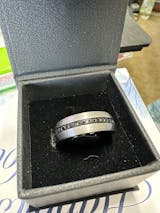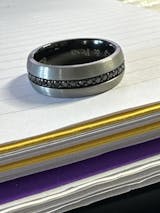
Traditional wedding bands have long been a symbol of love and commitment, representing the endless bond between a married couple. These classic rings come in various styles and materials, ensuring there's something for everyone. For those who appreciate time-honored designs, traditional wedding bands are the perfect choice.
Men's wedding bands, in particular, offer a range of options, from simple and sleek to more intricate designs. Classic men's rings tend to be wider and more substantial, while still maintaining a timeless aesthetic. Some popular styles for men include carved, textured, or plain bands, allowing grooms to find a ring that truly suits their taste and personality.
When selecting a traditional wedding band, it's important to consider factors such as metal type, width, and comfort. Gold and platinum are popular choices for their durability and luster, but alternative metals like titanium and tungsten carbide are also gaining popularity. Ultimately, finding the perfect ring comes down to the wearer's preferences and lifestyle, ensuring their wedding band remains a cherished symbol of their lasting love.
The History and Tradition of Wedding Bands
Wedding band origins can be traced to ancient Egyptian, Greek, and Roman cultures, where the circle represented eternity. Pharaohs of Egypt were among the first to use these circular shapes as symbols of eternal love.
Fast forward to Roman times, wedding rings became a public pledge to honor the marriage contract. Traditionally made of precious metals like gold or platinum, wedding rings continue to represent the everlasting bond between two people.
As the tradition evolved, so did the styles and designs of wedding bands. In North America, cities like Los Angeles, New York, San Diego, and Houston have seen trends in wedding bands come and go. From simple gold bands to intricate designs and even diamond-encrusted rings, couples now have a vast array of choices to express their love and commitment.
It's not just the design that has changed over time, but also the customs surrounding the wedding band. In many Western cultures, such as in the United States, it's common for both partners to wear a wedding band on their left hand's ring finger. This tradition stems from the belief that a vein in this finger, called the "vena amoris" or "vein of love," is directly connected to the heart.
Why The Classics Still Work
Traditional wedding bands have stood the test of time for a reason. Their timeless, elegant design and simplicity make them a favorite choice among couples who want to symbolize their love and commitment without going over the top. Here are a few reasons why these classics continue to work so well.
First and foremost, classic wedding bands are versatile. They can easily complement the engagement ring without competing for attention. This is particularly true for metal bands, crafted from materials like platinum, titanium, or gold in various shades. They have a subtle elegance that pairs well with any engagement ring, regardless of design or gemstones.
Another great aspect of traditional wedding bands is their enduring style. Trends come and go, but a simple gold or platinum band will always remain stylish and relevant. This classic design transcends generations, making it a meaningful and cherished heirloom to pass down through the years. You don't have to worry about your wedding band looking dated as the years go by, as its simplicity ensures it will remain in vogue.
Not only are classic wedding bands aesthetically pleasing, they're also practical. A plain band, whether rounded or flat, usually has no embellishments like diamonds or other stones. This makes them easier to maintain and clean throughout the years. Moreover, with fewer elements, there's less chance of damage or wear on the ring's surface.
Traditional wedding bands cater to everyone's personal taste. If you prefer a more minimalist approach, a simple metal band in your choice of color may be just what you're looking for. On the other hand, if you'd like something slightly more unique, there are plenty of options for adding simple engravings or unique finishes while still respecting the timeless tradition of a classic wedding band.
Stones in Traditional Wedding Bands
Wondering about the different types of stones that can be incorporated into the design? There are several options to consider, but some of the most popular choices include diamonds, eternity rings, and other gemstones.
Diamonds are often the go-to choice for many couples, as they symbolize love, commitment, and durability. Since they're the hardest natural substance on earth, the diamond's enduring nature makes it a fitting representation of your everlasting bond. You can choose from different settings and diamond cuts to amplify the beauty and sparkle of your ring.
Eternity rings represent another popular option for wedding bands with stones. These rings consist of a continuous line of identical stones – often diamonds – surrounding the entire band. The unbroken circle of gemstones represents eternal love and commitment between you and your partner. You can select from different shapes and sizes of stones, as well as various precious metals for the band itself.
In addition to diamonds and eternity rings, there are also various other gemstones you can incorporate in your traditional wedding band. This may include natural stones, such as sapphires, emeralds, or rubies. These colorful options can add a unique touch to your wedding band while still adhering to the classic design aesthetic. You could even combine different gemstones with diamonds for a truly distinctive look.

Modern Twists on Classic Wedding Bands
Classic wedding rings have a timeless appeal and are often made from gold or platinum. However, modern trends are giving these traditional bands a unique twist. Let's dive into some of these fashionable changes.
One of the most significant shifts in recent years has been the use of alternative metals, such as titanium, tungsten, and cobalt. These metals provide a fresh look, combined with excellent durability, making them perfect for active individuals or couples seeking a unique style.
Another exciting development is the incorporation of textures and finishes on classic wedding bands. You may find rings with alternating finishes, such as matte and polished, or even intricate patterns etched into the surface. This touch of artistic flair can turn a simple band into a trendy and distinctive piece.
Diamond accents have also found their way into modern twists on traditional wedding bands. Subtle arrangements of diamonds can elevate the sophistication and elegance of a ring without making it look too flashy. Even men who might shy away from overt diamond designs can embrace this subtle nod to luxury.
The traditional solid gold wedding band can still maintain its classic charm while embracing contemporary trends. For women, a thin gold band accented with smaller diamonds makes a stylish statement. Men can experiment with unique finishes and textures on gold rings to add their personal touch.
By merging classic and modern elements, couples can create a wedding band that represents their unique bond and style. It's all about finding a balance between tradition and individuality, allowing them to celebrate their love in a way that feels truly personal.




